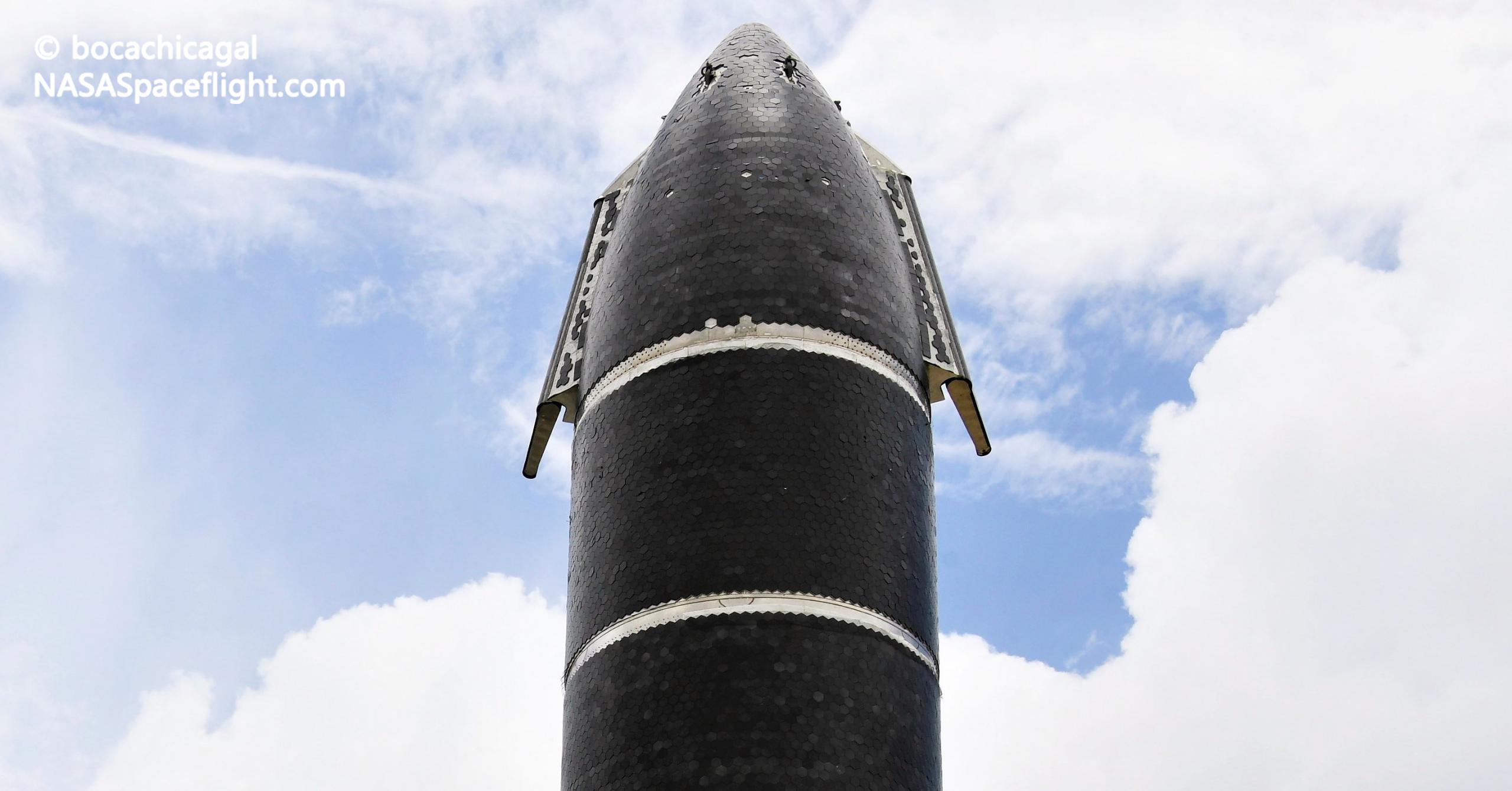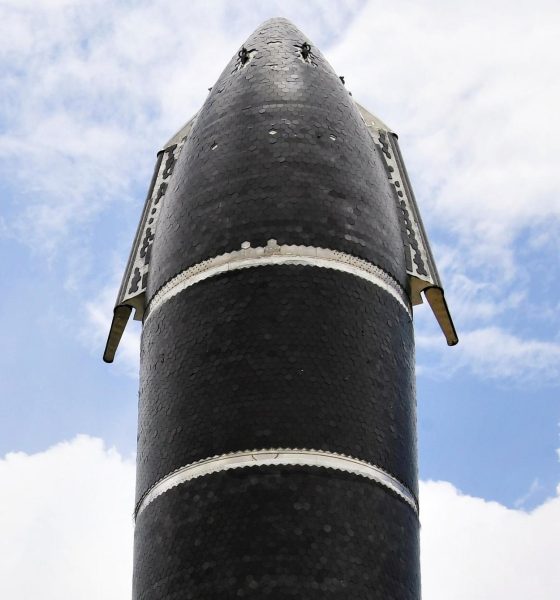

News
SpaceX to shrink, tweak Starship’s forward flap design, says Elon Musk
SpaceX CEO Elon Musk says that there is a “slight error” with the current design of Starship’s forward flaps, necessitating a few small but visible changes on future prototypes of the spacecraft.
Measuring 9m (30 ft) wide and approximately 50m (~165 ft) from tip to tail, Starship is the combined upper stage, spacecraft, tanker, and lander of a two-stage, fully-reusable rocket with the same name. While SpaceX has a long ways to go to achieve it, the company’s ambition is for Starship and its Super Heavy booster to be the most easily and quickly reusable spacecraft and rocket booster ever built, nominally enabling the same-day reuse of both.
Beyond a Space Shuttle-style heat shield of blankets and ceramic tiles, the Starship upper stage is meant to achieve that reusability by descending through the atmosphere and landing unlike any other spacecraft, plane, or rocket ever flown. Instead of flying, gliding, or knifing through the atmosphere nose or tail-first, Starship freefalls perpendicular to the ground for the last few dozen kilometers (~10-20 mi) before aggressively flipping into a vertical orientation at the last second and landing propulsively on its tail. Now, according to Elon Musk, two of the four ‘flaps’ that largely make that exotic maneuver possible are set for a small but significant redesign.
Probably slightly further forward, smaller, more inward. No funny looking static aero at top, as static aero no longer directly in flow.— Elon Musk (@elonmusk) August 18, 2021
Over the course of five suborbital test flights of full-scale Starship prototypes completed between December 2020 and May 2021, SpaceX took that exotic landing concept from the drawing board and subscale wind tunnel testing to reality. Though four of those five tests ended in destruction, their respective Starship prototypes really only failed in the last 15-30 seconds of test flights that were more than six minutes long.
After reaching an apogee of 10-12.5 km (~6.2-7.8 mi) over the course of some four and a half minutes, all five Starship prototypes successfully shut down their Raptor engines, tipped over onto their bellies, and then used a combination of small pressurized gas thrusters and four large flaps to stably fall back to Earth. Much like a skydiver can tweak their body, arms, and legs to control their orientation and attitude, Starship uses two pairs of forward and aft flaps to achieve a very similar level of control.
Thanks to Starship’s significant surface area and relatively low mass shortly before landing, that unprecedented freefall-style descent naturally slows the rocket to just 100-200 mph (~50-100 m/s) while simultaneously allowing SpaceX to avoid the massive complexity and added mass of structural wings or fins like those on the Space Shuttle. Further, whereas the Shuttle used its wings to glide (albeit like a brick) and land on very long runways, Starship is designed to use three of its six Raptor engines to flip into a vertical orientation and land much like SpaceX’s own spectacularly successful Falcon boosters.
During the actual process of reentry, in which Starship uses a heat shield made up of ~15,000 ceramic tiles to slow from orbital (Mach 25 or ~7.5 km/s) to subsonic speeds, those same flaps also come in useful to control the vehicle’s angle of attack and thus the degree of extreme heating experienced. According to Musk, to improve the moment arm (i.e. leverage or, all else equal, torque) of Starship’s forward flaps and reduce or remove undesirable aerodynamic characteristics, SpaceX is going to shrink those forward flaps further, move them closer together and more towards the tip of Starship’s nose, and angle them toward the ship’s leeward side (back).
Apparently, those relatively minor changes mean that a portion of Starship’s forward flaps will no longer be directly subjected to reentry heating, potentially allowing SpaceX to entirely remove static “aerocovers” that wrap around the ship’s flaps to prevent superheated plasma and gas from reaching sensitive components. Ironically, SpaceX’s thermal protection team completed the installation of heat shield tiles on one of those forward flap aerocovers for the first time ever just a few days ago – a structure and portion of heat shield that will apparently no longer be needed on future Starships.
For now, though, it looks like Ship 20 will attempt Starship’s first orbital launch with its now-outdated forward flaps. Depending on how far along Ship 21 production is, the next prototype could feasibly sport that new flap design.

News
Tesla FSD fleet is nearing 7 billion total miles, including 2.5 billion city miles
As can be seen on Tesla’s official FSD webpage, vehicles equipped with the system have now navigated over 6.99 billion miles.

Tesla’s Full Self-Driving (Supervised) fleet is closing in on almost 7 billion total miles driven, as per data posted by the company on its official FSD webpage.
These figures hint at the massive scale of data fueling Tesla’s rapid FSD improvements, which have been quite notable as of late.
FSD mileage milestones
As can be seen on Tesla’s official FSD webpage, vehicles equipped with the system have now navigated over 6.99 billion miles. Tesla owner and avid FSD tester Whole Mars Catalog also shared a screenshot indicating that from the nearly 7 billion miles traveled by the FSD fleet, more than 2.5 billion miles were driven inside cities.
City miles are particularly valuable for complex urban scenarios like unprotected turns, pedestrian interactions, and traffic lights. This is also the difference-maker for FSD, as only complex solutions, such as Waymo’s self-driving taxis, operate similarly on inner-city streets. And even then, incidents such as the San Francisco blackouts have proven challenging for sensor-rich vehicles like Waymos.
Tesla’s data edge
Tesla has a number of advantages in the autonomous vehicle sector, one of which is the size of its fleet and the number of vehicles training FSD on real-world roads. Tesla’s nearly 7 billion FSD miles then allow the company to roll out updates that make its vehicles behave like they are being driven by experienced drivers, even if they are operating on their own.
So notable are Tesla’s improvements to FSD that NVIDIA Director of Robotics Jim Fan, after experiencing FSD v14, noted that the system is the first AI that passes what he described as a “Physical Turing Test.”
“Despite knowing exactly how robot learning works, I still find it magical watching the steering wheel turn by itself. First it feels surreal, next it becomes routine. Then, like the smartphone, taking it away actively hurts. This is how humanity gets rewired and glued to god-like technologies,” Fan wrote in a post on X.
News
Tesla starts showing how FSD will change lives in Europe
Local officials tested the system on narrow country roads and were impressed by FSD’s smooth, human-like driving, with some calling the service a game-changer for everyday life in areas that are far from urban centers.

Tesla has launched Europe’s first public shuttle service using Full Self-Driving (Supervised) in the rural Eifelkreis Bitburg-Prüm region of Germany, demonstrating how the technology can restore independence and mobility for people who struggle with limited transport options.
Local officials tested the system on narrow country roads and were impressed by FSD’s smooth, human-like driving, with some calling the service a game-changer for everyday life in areas that are far from urban centers.
Officials see real impact on rural residents
Arzfeld Mayor Johannes Kuhl and District Administrator Andreas Kruppert personally tested the Tesla shuttle service. This allowed them to see just how well FSD navigated winding lanes and rural roads confidently. Kruppert said, “Autonomous driving sounds like science fiction to many, but we simply see here that it works totally well in rural regions too.” Kuhl, for his part, also noted that FSD “feels like a very experienced driver.”
The pilot complements the area’s “Citizen Bus” program, which provides on-demand rides for elderly residents who can no longer drive themselves. Tesla Europe shared a video of a demonstration of the service, highlighting how FSD gives people their freedom back, even in places where public transport is not as prevalent.
What the Ministry for Economic Affairs and Transport says
Rhineland-Palatinate’s Minister Daniela Schmitt supported the project, praising the collaboration that made this “first of its kind in Europe” possible. As per the ministry, the rural rollout for the service shows FSD’s potential beyond major cities, and it delivers tangible benefits like grocery runs, doctor visits, and social connections for isolated residents.
“Reliable and flexible mobility is especially vital in rural areas. With the launch of a shuttle service using self-driving vehicles (FSD supervised) by Tesla in the Eifelkreis Bitburg-Prüm, an innovative pilot project is now getting underway that complements local community bus services. It is the first project of its kind in Europe.
“The result is a real gain for rural mobility: greater accessibility, more flexibility and tangible benefits for everyday life. A strong signal for innovation, cooperation and future-oriented mobility beyond urban centers,” the ministry wrote in a LinkedIn post.
News
Tesla China quietly posts Robotaxi-related job listing
Tesla China is currently seeking a Low Voltage Electrical Engineer to work on circuit board design for the company’s autonomous vehicles.

Tesla has posted a new job listing in Shanghai explicitly tied to its Robotaxi program, fueling speculation that the company is preparing to launch its dedicated autonomous ride-hailing service in China.
As noted in the listing, Tesla China is currently seeking a Low Voltage Electrical Engineer to work on circuit board design for the company’s autonomous vehicles.
Robotaxi-specific role
The listing, which was shared on social media platform X by industry watcher @tslaming, suggested that Tesla China is looking to fill the role urgently. The job listing itself specifically mentions that the person hired for the role will be working on the Low Voltage Hardware team, which would design the circuit boards that would serve as the nervous system of the Robotaxi.
Key tasks for the role, as indicated in the job listing, include collaboration with PCB layout, firmware, mechanical, program management, and validation teams, among other responsibilities. The role is based in Shanghai.
China Robotaxi launch
China represents a massive potential market for robotaxis, with its dense urban centers and supportive policies in select cities. Tesla has limited permission to roll out FSD in the country, though despite this, its vehicles have been hailed as among the best in the market when it comes to autonomous features. So far, at least, it appears that China supports Tesla’s FSD and Robotaxi rollout.
This was hinted at in November, when Tesla brought the Cybercab to the 8th China International Import Expo (CIIE) in Shanghai, marking the first time that the autonomous two-seater was brought to the Asia-Pacific region. The vehicle, despite not having a release date in China, received a significant amount of interest among the event’s attendees.








